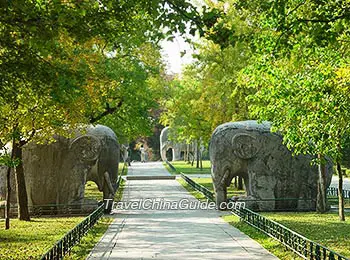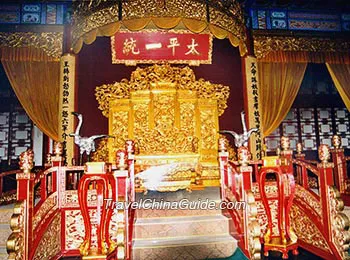Nanjing History
Human Traces in Prehistoric Time
Ancient humans appeared in the Nanjing area 1 to 1.2 million years ago, and ape men began to live here 350,000 to 600,000 years ago. In the Neolithic Age, about 7,000 to 8,000 years ago, primitive tribes came into existence. Relics of this period have been unearthed, including pottery and tools made of stones and animal bones. 3,000 years ago, rudimentary villages appeared in the Qinhuai River Valley, and based on these villages, the prototype of Nanjing city began to form 2,600 years ago.
When was Nanjing founded? 571BC or 472BC
In 571BC, nearly 2,600 years ago, a small village called Tangyi was situated in today’s Liuhe District, a northern suburb of Nanjing. This is the earliest written record of Nanjing as a city.
More Cities Set in Nanjing in the Late Eastern Zhou (600-221BC)
In the late Spring and Autumn Period (600-476BC), Yecheng City, a group of handicraft workshops, was established to refine bronzeware near today’s Chaotian Palace in Qinhuai District. In 333 BC during the Warring States Period (475-221BC), King Wei of Chu State decided to found a town in today’s Qingliang Mountain in Gulou District and named it Jinling. At that time, Jinling was just a little military. Nevertheless, compared with Yue City mentioned above, Jinling marks the beginning of administrative division in Nanjing history.
Made a Capital for the First Time in 229 AD
In 229 AD, Sun Quan made it the capital of the Kingdom of Wu (222-280) and called it Jianye. It was the first time that Nanjing had been designated as a capital. As a result, China’s political center was shifted from the Yellow River region to the Yangtze River region. This exerted a profound influence on the later development of the southern region of China.
The Capital for Six Dynasties (222-589 AD)
After the Kingdom of Wu, Nanjing served as the capital of five subsequent dynasties, Eastern Jin (317-420), Southern Song (420-479), Southern Qi (479-502), Southern Liang (502-557) and Southern Chen (557-589), and its name was changed from ‘Jianye’ into ‘Jiankang’. During this time period, Jiankang was the largest city in the world with more than one million people. It was also considered the center of world’s civilization, equal to Rome. Such prosperity applied to numerous aspects, including marine trade, handicraft industry, architecture, the development of Confucianism, Buddhism, Taoism, and so on.
Descending Political Status in Sui (581-618) and Tang Dynasty (618-907)
Following 300 years of prosperity, Nanjing spiraled downwards during the Sui and Tang Dynasty. At that time the Tang Court became worried about separatist regimes and downgraded Nanjing, then called Jinling, from a capital into a prefecture or county. Though no longer a capital city, relics of former dynasties were frequently visited and quoted by poets and scholars, in order to lament the evanescent prosperity in Nanjing history.
Capital of Southern Tang (937-975) and Important Town from Song to Yuan Dynasty (960-1368)
During the Five Dynasties and Ten States Period of the late Tang Dynasty, Jinling was again made the capital of Southern Tang (937-975), and partly recovered. In this period, much emphasis was placed on the agriculture, commerce and art. From then on, Nanjing was an important town in southeast China until the Yuan Dynasty.
Made the Capital of Ming in 1368 and Another Boom
 |
| Stone Elephants Statues along the Sacred Way, Mausoleum of Zhu Yuanzhang |
In 1368, Zhu Yuanzhang established the Ming Dynasty (1368 - 1644) and made Nanjing the capital city. In the early Ming Dynasty, Nanjing was the largest city in the country with a population of 700,000. Besides, it attracted many foreign students from Japan, Korea and Vietnam. In 1421, the capital of Ming was shifted to Beijing but Nanjing still functioned as an auxiliary capital. Until the middle Ming Dynasty, Nanjing had a population of 1.2 million, making it the largest capital in the world. The Italian missionary Matteo Ricci wrote in his book, ‘This city is so prosperous that it is able to stand comparison with any large European capital in 16th century’.
Modern History Unveiled from Treaty of Nanking in 1842
On August 29th, 1842, the Qing Government signed the Treaty of Nanking with Britain in order to end the Opium Wars, which was a disgraceful day in Nanjing history. Three terms in this treaty, agreement on tariffs, consular jurisdiction and unilateral most-favored-nation treatment, changed China into a semi-colonial and semi-feudal society. This marked the beginning of modern Chinese history.
Taiping Kingdom of Heaven from 1853 to 1864
 |
| Zhanyuan Garden, Former Residence of the Taiping Rebellion Leaders |
In order to cover the considerable military expenditure and reparations arising from the Opium Wars, the Qing Government exploited the grassroots and confiscated their savings. This triggered the internal peasant war. In 1853, the Taiping Army conquered Nanjing and established the Taiping Kingdom of Heaven, however, this regime collapsed after a short period
Political Center of the Republic of China (1912-1949)
On January 1st, 1912, the Provisional Government of the Republic of China was established in Nanjing and Sun Yet-san became the provisional president. The period from 1927 to 1937 is called the ‘golden decade’ in Nanjing history because the large-scale municipal infrastructure was established, which lays the foundation of modern development in Nanjing. However, its important political position resulted in the outrageous Nanjing Massacre.
What happened in the Nanjing Massacre?
For six weeks starting December 13th, 1937, the Japanese army indiscriminately committed violence in Nanjing including massacre, rape, fire setting and plunder. There were more than three hundred thousand victims, most of them unarmed and defenseless civilians. The first unhuman violence was large-scale massacre. Civilians were tied together with wire and shot by machine guns. Then, the bodies were burn with diesel. Some people were collectively buried alive. Even worse, two Japanese military officers launched a competition of killing people. The one who killed one hundred people faster was called ‘hero’. According to the military court, during the six-week Nanjing Massacre, there were 28 cases of collective massacre, 858 cases of sporadic massacre, and more than twenty thousand cases of rape. In addition, thirty one percent of the buildings in Nanjing were destroyed and 880,000 publications, along with other precious cultural relics, were plundered.
On April 23rd, 1949, the Communist Party of China took over Nanjing.
![]() See also:
See also:
Nanjing Massacre Pictures
Today’s Nanjing
Through the revitalization of several decades, Nanjing has now become an important city in the Yangtze River Delta and southern China. It serves as the hub of national logistics and transportation. Local higher education institutes like Nanjing University and Southeast University also ensure a brighter future of this city.